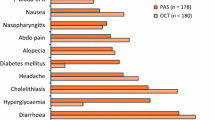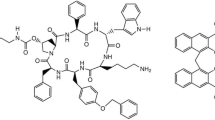Abstract
A 52-year-old female with metastatic glucagonoma secreting glucagon and chromogranin A was treated with the somatostatin analogue octreotide for 2 years without any additional tumor-reducing interventions. Before therapy plasma glucagon was above 8 μg/l (normal <0.2) and within 2 days 3 × 200 μg octreotide daily suppressed plasma glucagon to 2.2–2.5 μg/l. Concomitantly, chromogranin A dropped from 0.85 mg/l (normal <0.1) to 0.2. After 3 weeks the preexisting disabling necrolytic migratory erythema had vanished completely, and weight loss was temporarily stopped. During therapy chromogranin A and plasma glucagon rose, exceeding pretreatment levels after 3 and 14 months, respectively. After 1 year the erythema recurred, responding only transiently to increasing doses of octreotide. The patient died after 2 years of therapy of tumor cachexy despite very highdosesof octreotide (4 × 600 μg/day). Throughout treatment octreotide did not prevent tumor growth, as demonstrated by computed tomography and sonography. Determination of immunoreactive glucagon before and during octreotide therapy in fractions of plasma samples subjected to gel chromatography revealed a reduction in the ratio of glucagon to preproglucagon from 1.83 (before) to 0.56 (during therapy), indicating inhibition of posttranslational processing of preproglucagon by octreotide, thereby reducing circulating bioactive glucagon. In summary, octreotide induced a remission of clinical symptoms by inhibiting posttranslational conversion of preproglucagon to glucagon but did not prevent tumor growth. Therefore, octreotide is a valuable therapy for rapid relief of clinical symptoms, thereby improving the possibilities for other tumor-reducing therapies.
Similar content being viewed by others
Abbreviations
- CGA:
-
chromogranin A
- IRG:
-
immunoreactive glucagon
- OC:
-
octreotide
References
Anderson JV, Bloom SR (1986) Neuroendocrine tumors of the gut: long-term therapy with the somatostatin analogue SMS 201–995. Scand J Gastroenterol 21 [Suppl 119]: 115–128
Assan R, Slusher N (1972) Structure/function and structure/ immunoreactivity relationships of the glucagon molecule and related synthetic peptides. Diabetes 21:843–855
Bakker WH, Albert R, Bruns C, Breeman WAP, Holland LJ, Marbach P, Pless J, Pralet D, Stolz B, Koper JW, Lamberts SWJ, Visser TJ, Krenning EP (1991) [111In-DTPA-D-Phe1]-Octreotide, a potential radiopharmaceutical for imaging of somatostatin receptor-positive tumors: synthesis, radiolabeling and in vitro validation. Life Sci 49:1583–1591
Bender H, Maier A, Wiedenmann B, O'Connor DT, Messner K, Schmidt-Gayk H (1992) Immunoluminometric assay of chromogranin A in serum with commercially available reagents. Clin Chem 38:2267–2272
Bloom SR, Polak JM (1987) Glucagonoma syndrome. Am J Med 82:25–36
Danforth DN, Triche T, Doppman JL, Beazley RM, Perrino PV, Recant L (1976) Elevated plasma proglucagon-like component with a glucagon-secreting tumor. N Engl J Med 295:242–245
Fujita J, Seino Y, Ishida H, Taminato T, Matsukura S, Horio T, Imamura S, Naito A, Tobe T, Takahashi K, Midorikawa O, Imura H (1986) A functional study of a case of glucagonoma exhibiting typical glucagonoma syndrome. Cancer 570:860–865
Gorden P, Comi RJ, Maton PN, Go VLW (1989) Somatostatin and somatostatin analogue (SMS 201–995) in treatment of hormone-secreting tumors of the pituitary and gastrointestinal tract and non-neoplastic diseases of the gut. Ann Intern Med 110:35–50
Hallengren B, Dymling JF, Manhem P, Tennvall L, Tibblin S (1983) Unsuccessful DTIC treatment of a patient with glucagonoma syndrome. Acta Med Scand 213:317–318
Harris V, Faloona GR, Unger RH (1979) Glucagon. In: Jaffe BM, Behrmann HR (eds) Methods of hormone radioimmunoassay. Academic Press, New York, pp 643–656
Holst JJ (1983) Molecular heterogeneity of glucagon in normal subjects and in patients with glucagon-producing tumors. Diabetol 24:359–365
Jaspan J, Rubenstein AH (1977) Circulating glucagon. Diabetes 26:887–902
Jockenhövel F, Reinwein D (1992) Das Glukagonom: klinische Aspekte, Diagnostik und Therapie. Aktuel Endokrinol 13:66–80
Karnofsky DA, Burchenal JH (1949) The clinical evaluation of chemotherapeutic agents. In: McLeod MA (ed) Evaluation of chemotherapeutic agents. Columbia University Press, New York, pp 191–205
Krenning EP, Bakker WH, Kooij PPM, Breeman WAP, Oei HY, de Jong M, Reubi JC, Visser TJ, Bruns C, Kwekkeboom DJ, Reijs AEM, van Hagen PM, Koper JW, Lamberts SWJ (1992) Somatostatin receptor scintigraphy with indium-111-DTPA-D-Phe-l-octreotide in man: metabolism, dosimetry and comparison with iodine- 123-Tyr-3-octreotide. J Nucl Med 33:652–658
Lucey MR, Yamada T (1989) Biochemistry and physiology of gastrointestinal somatostatin. Dig Dis Sci 34:5S–13S
Maton PN, Gardner JD, Jensen RT (1989) Use of long-acting somatostatin analog SMS 201–995 in patients with pancreatic islet cell tumors. Dig Dis Sci 34:285–355
Moertel CG, Lefkopoulo M, Lipsitz S, Hahn RG, Klaassen D (1992) Streptozocin-doxorubucin, streptozocin-fluorouracil, or chlorozoticin in the treatment of advanced islet-cell carcinoma. N Engl J Med 326:519–523
Recant L, Perrino PV, Bhathena SJ, Danforth DN, lavine RL (1976) Plasma immunoreactive glucagon fractions in four cases of glucagonoma: increased “large glucagon-immunoreactivity.” Diabetologia 12:319–326
Rigopoulou D, Valverde I, Marco J, Faloona GR, Unger RH (1970) Large glucagon immunoreactivity in extracts of pancreas. J Biol Chem 245:496–501
Rosenbaum A, Flourie B, Chagnon S, Blery M, Modigliani R (1989) Octreotide (SMS 201–995) in the treatment of metastatic glucagonoma: report of one case and review of the literature. Digestion 42:116–120
Santangelo WC, Unger RH, Orci L, Dueno MI, Popina JJ, Krejs GJ (1986) Somatostatin analog-induced remission of necrolytic migratory erythema without changes in plasma glucagon concentration. Pancreas 1:464–469
Sobol RE, Memoli V, Deftos LJ (1989) Hormone-negative, chromogranin A positive endocrine tumors. N Engl J Med 320:444–447
Tanaka K, Watabe T, Shimizu N, Horiuchi T, Nakamura K, Yoshida H (1984) Immunologic characterization of plasma glucagon components in a patient with malignant glucagonoma. Metabolism 33:728–733
Valverde I, Lemon HM, Kessinger A, Unger RH (1976) Distribution of plasma glucagon immunoreactivity in a patient with suspected glucagonoma. J Clin Endocrinol Metab 42:804–808
Valverde I, Villanueva ML, Lozano I, Marco J (1974) Presence of glucagon immunoreactivity in the globulin fraction of human plasma (“big plasma glucagon”). J Clin Endocrinol Metab 39:1090–1098
von Schenck H, Nilsson OR (1981) Radioimmunoassay of extracted glucagon compared with three non-extracted assays. Clin Chim Acta 109:183–191
von Schenck H, Thorell JI, Berg J, Bojs G, Dymling JF, Hallengren B, Ljungberg O, Tibblin S (1979) Metabolic studies and glucagon gel filtration pattern before and after surgery in a case of glucagonoma syndrome. Acta Med Scand 205:155–162
Weir GC, Horton ES, Aoki TT, Slovik D, Jaspan J, Rubenstein AH (1977) Secretion by glucagonomas of a possible glucagon precursor. J Clin Invest 59:325–330
Williams G, Anderson JV, Williams SJ, Bloom SR (1987) Clinical evaluation of SMS 201–995. Acta Endocrinol 116 [Suppl] 286:26–36
Author information
Authors and Affiliations
Additional information
Correspondence to: D. Reinwein
Rights and permissions
About this article
Cite this article
Jockenhövel, F., Lederbogen, S., Olbricht, T. et al. The long-acting somatostatin analogue octreotide alleviates symptoms by reducing posttranslational conversion of prepro-glucagon to glucagon in a patient with malignant glucagonoma, but does not prevent tumor growth. Clin Investig 72, 127–133 (1994). https://doi.org/10.1007/BF00184589
Received:
Accepted:
Published:
Issue Date:
DOI: https://doi.org/10.1007/BF00184589




